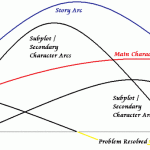In last night’s new novel writing class, I asked students to bring in a novel they admire or like. Next week, I’ll tell them that they’ll never be able to read a book the way they’ve read in the past. Why? Because, as writers, we’re much more apt to have x-ray vision, seeing through the story all the way to its bones.
Writing Tip for Today: Whenever I talk to a writer who says she/he doesn’t read much, I cringe inside. Writers must also read. Read for pleasure, read for information, and also read for structural analysis. What do I mean?
The first time you read a novel, don’t stop to analyze–just enjoy. Later, you’ll be able to assess the same book in different ways:
- Examine the novel’s opening line or paragraph. What information about the story do you learn here? Is there at least a hint of the novel’s theme or premise?
- Where does the first dialogue occur? Often dialogue is an easy way to identify a scene. If there are pages of narrative (telling) before the first scene, how do you think the writer keeps us reading until the action begins?
- What’s happening in the book’s middle? Many novels’ tension sags here. How does the author maintain your interest?
- Where is the climax of the book? This is the biggest moment of the novel, where the character must act. Chances are, it’s nearly at the end.
- How much longer after the climax does the novel go on? This is the resolution or denouement. Most good stories “get out quick” after the central problem has been faced.
Try This! Now take a look at your own work. Go through each of the areas described above and see how your story stacks up.





This is so true. And the good news is that as a writer I gain soooo much more enjoyment, education and insight into my own writing with every novel and essay I read.
It’s a long way from those elementary school book report days, huh? Most writers, when they begin to understand how stories work, gain a new respect for the novel writing process. –Linda